What does your winter garden look like?
Do you even have a ‘winter garden’ as such?
I find that the garden becomes a bit of a dumping ground between November and February.
But sometimes the light catches the bark of a silver birch, or the frost outlines dying seedheads. It is so poignantly beautiful that I realise how much winter has to offer gardens.
Gardens used to be able to snooze through winter, but today’s glass kitchen extensions, massive glass sliding doors and huge picture windows mean a middle-sized garden is on show all year round.
So I went to RHS Hyde Hall to talk to garden manager, Andrew Hellman, about the new winter garden they’re creating.

RHS Hyde Hall in Essex in November. It’s a garden with year round interest.
I wasn’t entirely sure what a ‘winter garden’ was. I imagined something with lots of evergreen trees and topiary, which would make crisp frosted outlines on freezing winter mornings.
To my surprise, there wasn’t an evergreen tree or a topiarised shrub in sight.
‘A winter garden is all about the light,’ explained Andrew. He advises you to look out of your window (or your glass bi-fold doors…). Observe where the sunlight falls over the day, and plan appropriately.
‘There’s a wonderful slanting sunlight in the winter,’ he says. ‘Some plants, such as grasses, look wonderful when they’re backlit. Others, such as cornus, look best when the sun is shining on them.’

Cornus look best when the sun shines on them, but grasses sing with the light behind them.
As today’s ‘winter gardens’ are close to the house, where they can be seen, it’s essential to choose plants which look good in more than one season.
For the RHS Hyde Hall winter garden (and yours) that means shrubs with good winter stem colour, such as cornus. Or choose trees which reveal beautiful bark when they drop their leaves.
Next, think about how your herbaceous plants will hold their shape even when their colour is gone. This includes grasses and plants such as salvias, echinacea, sedum, phlomis and thalictrum.
Finally, include a few shrubs with winter interest or scent, such as daphne or callicarpa.
So, specifically, what does Andrew recommend for the middle-sized winter gardens?
1) Trees for winter gardens
Fruit trees are good because they don’t grow too big. Choose trees with spring blossom and autumn colour or ones that hang onto fruits and berries for a long time.
At RHS Hyde Hall, they choose crab apples that hold their fruit, although Andrew admits that he forgot about this factor in his own garden. ‘I planted a crab apple, waited a few years for it to fruit, and then realised it wasn’t good at holding onto it.’ It’s nice to know that even the experts can get it wrong.
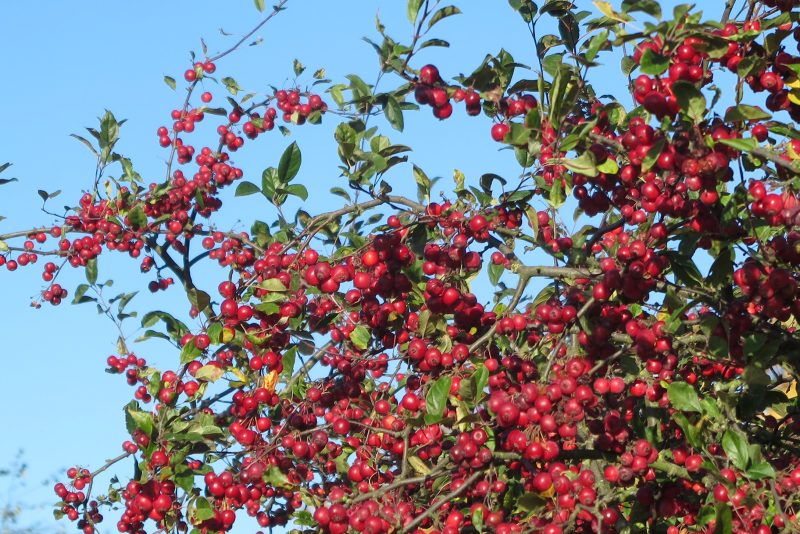
Malus ‘Gorgeous’ living up to its name at RHS Hyde Hall. Choose a crab apple that ‘holds onto’ its fruit for longer during the winter.
So he suggests malus ‘Adirondack’ or the slightly larger malus ‘Gorgeous’, which was looking particularly lovely during my visit to Hyde Hall. Both have masses of white flowers in spring, and long-lasting colourful fruit.
2) Trees with beautiful bark
Trees don’t have to keep their leaves to be beautiful. Andrew is planting a range of trees for their bark in the Hyde Hall winter garden. These include the ghostly grey Gingko biloba (see below) and a golden-barked Prunus Maackii ‘Amber Beauty’ (see the video below for a view of its golden polished trunk).
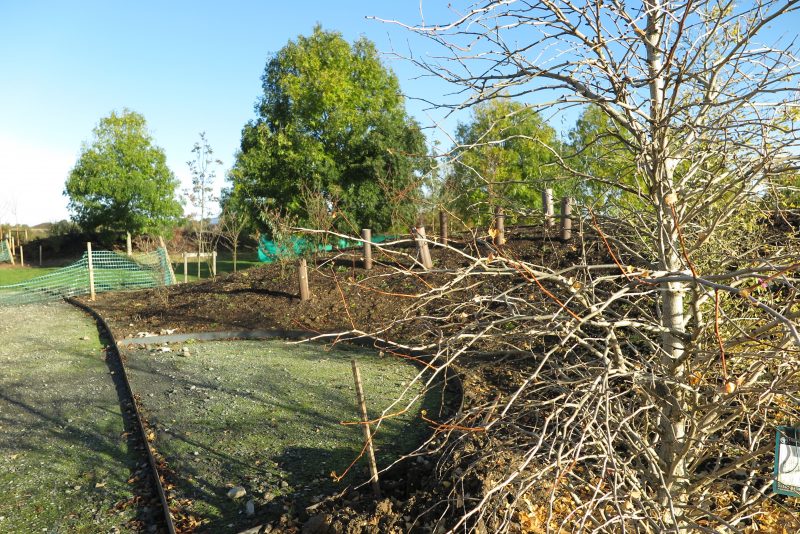
The ghostly texture of gingko biloba without its leaves at Hyde Hall.
3) Shrubs for winter interest
For scent, Andrew suggests that you tuck a sarcococca confusa or Christmas box in somewhere. It’s an evergreen, and has the most glorious white flowers and winter scent.
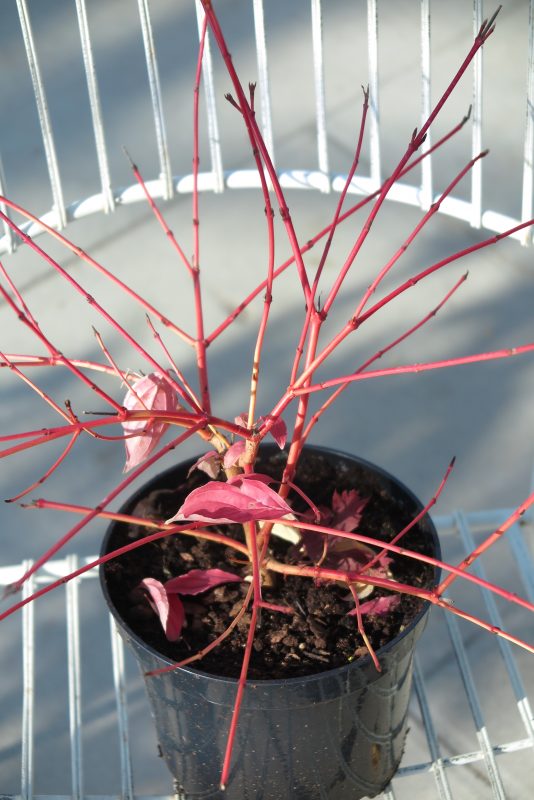
Cornus sanguinea ‘Anny’s Winter Orange’ – recommend by Andrew for its intense winter colour.
Cornus, of course, reigns supreme when it comes to winter stem colour. Andrew advises you to place it where the sun will fall on the stems – which will make their colour richer. His recommended favourite is Anny’s Winter Orange.
4) Purple ‘beauty berry’
Andrew recommends callicarpa ‘Profusion’ as another good shrub for the middlesized winter garden. It has pale lilac flowers in early summer and incredible purple berries in autumn and winter. ‘They look as if someone had glued cake decorations onto the plant’, says Andrew. Its bronze spring foliage is sought-after for flower arrangements.

Callicarpa ‘Profusion’ has stunning winter berries. A striking addition to any winter garden.
Callicarpas have been difficult to grow in the past, because they’ve needed several plants grown together in order to fruit. However, ‘Profusion’ has an RHS Order of Merit and can be grown on its own.
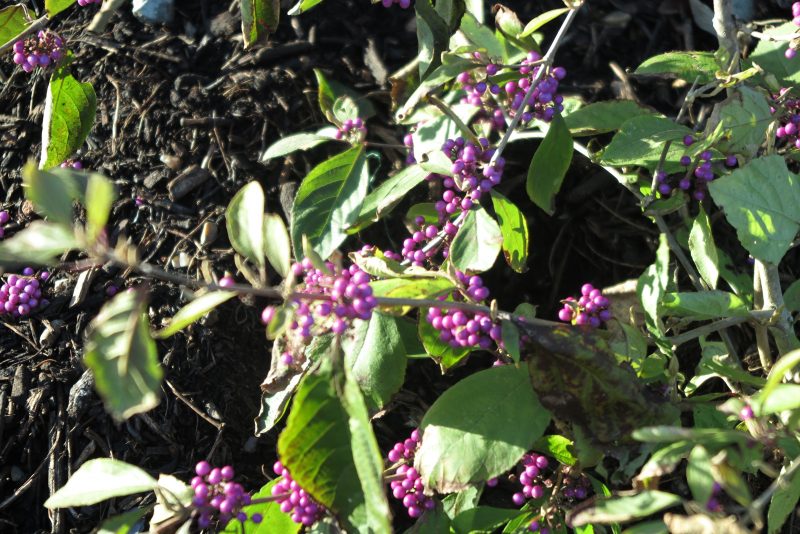
Callicarpa berries – it has pale lilac flowers in spring.
5) Create movement and drama
Grasses give a winter garden structure and movement. Andrew recommends Panicum ‘North Wind’ – it’s a large grass but is very columnar, so it doesn’t take up too much space. It’s very structural and has good autumn colour that fades to brown. It’ll go on looking good until you decide to clip it down in spring.’
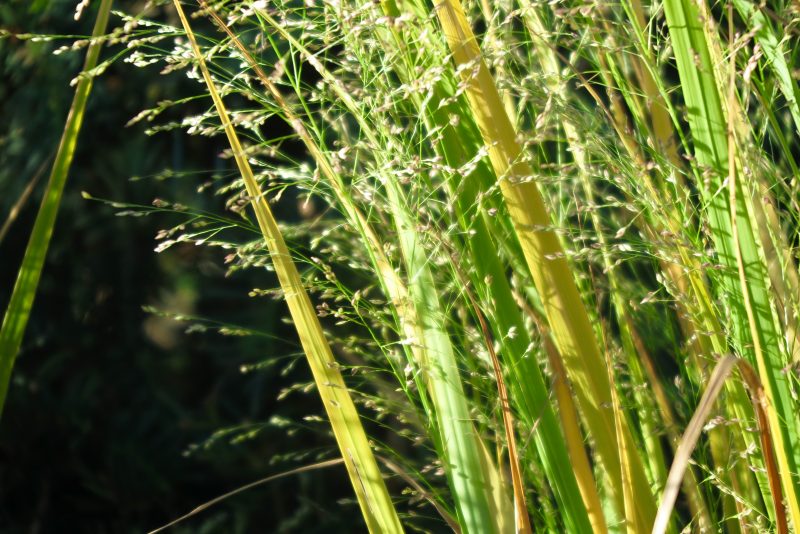
Panicum ‘North Wind’ will turn a richer colour as the winter progresses.
In the video below, Panicum ‘North Wind’ runs all along the left hand side of the first few frames, under-planted with bergenias.
6) Plant a winter garden for pollinating insects
Contrast shapes by placing verticals like grasses with low, spreading rounded flower heads. Sedum makes a great contrast to the vertical grasses and spires. Sedum ‘Matrona’ is one of the latest-flowering plants – ‘on a fine day, it’s swarming with pollinating insects,’ says Andrew.

Sedum ‘Matrona’ at Hyde Hall, halfway between its late summer ruby red and winter dark brown.
It’s also a ‘a winner for a long season of colour. It starts as a rich red and fades to a dark brown, while remaining very structural. ‘
7) Plant for summer colour and winter structure
Some plants hold their shape and flower or seed heads over the winter. They add good summer colour, then fade to brown. These include symphotricum (formerly aster), phlomis russeliana and echinacea. Andrew recommends Echinacea ‘Pallida’ (pale purple coneflower) as a more unusual version, which looks delicate but is actually tougher than some other cultivars.

This symphotricum has a pretty blue flower in late summer and autumn.
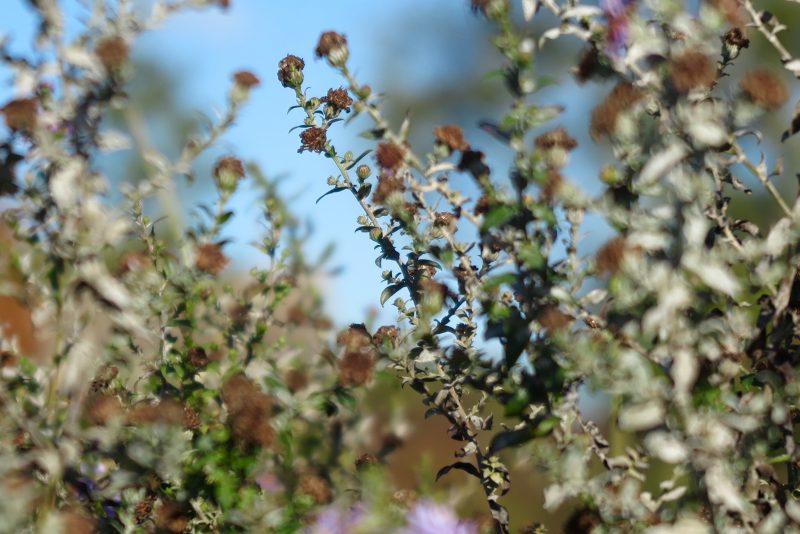
The same symphotricum, now adding texture and shape to a winter garden.
I didn’t see a single hydrangea at Hyde Hall, but I felt they deserve a mention in any post on winter gardens. Personally I love hydrangeas most in winter, especially when their dried flowers heads are iced with snow. I also think hydrangeas work particularly well in pots or against walls, so they suit more urban gardens than Hyde Hall.

My friend Emma’s black-stemmed hydrangea in August.
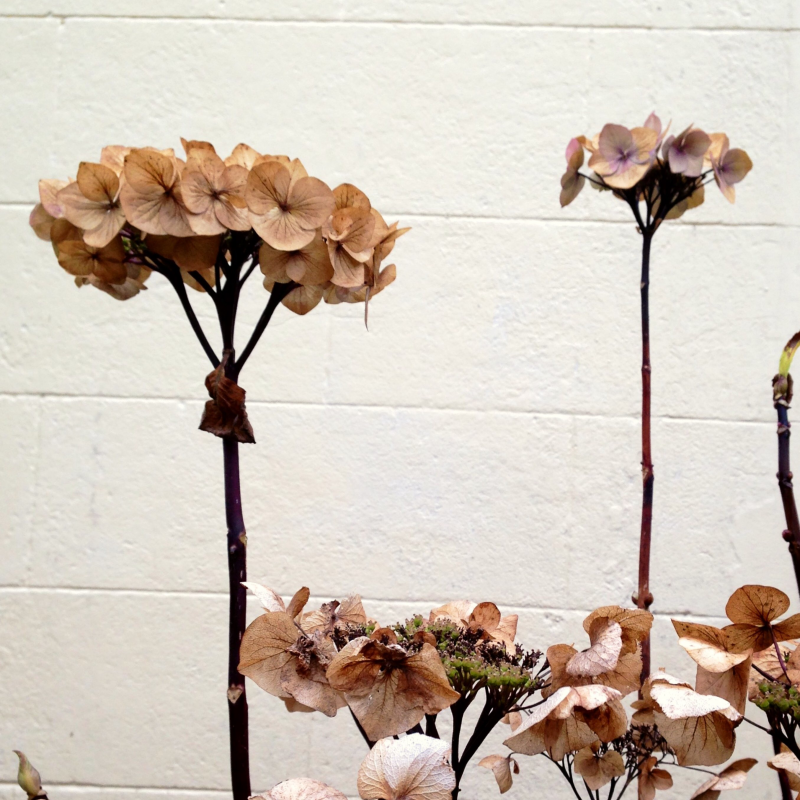
The same hydrangea in early January. I love its sculptural shape and copper colour.
8) Contrast shapes and sizes
When colour is subdued, then it’s particularly important to have a contrast of shape. Mix tall spires with lower, more rounded plants. Grasses and sedum can be a good combination. Andrew recommends Perovskia ‘Blue Spire’ for its lilac spires in summer and ghostly pale winter verticals.

Perovskia ‘Blue Spire’ in winter.
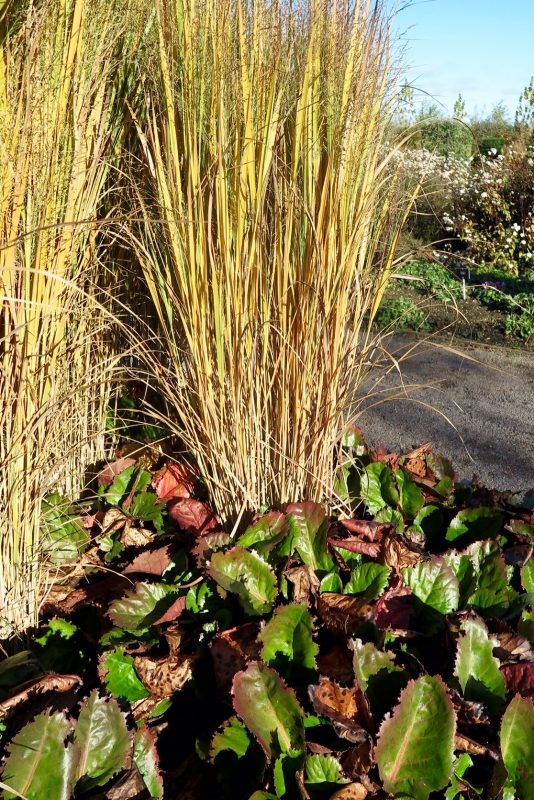
The tall, columnar Panicum ‘North Wind’ contrasting with low, large-leafed bergenia.
9) Think about early spring colour
Just as the late flowering plants feed pollinating insects towards the end of the year, a good winter garden will be a source of nectar for early pollinators. Andrew recommends bergenia, which flowers in early March and keeps its shape throughout the year. ‘It’s good for filling gaps at the edge of a border or to line a path,’ he says.
10) Tidy the edges – not the beds
One last tip from Andrew
We are all now advised to leave piles of fallen leaves or debris in beds, and not to be too tidy over winter. It helps wildlife and allows leaves to rot down, restoring their nutrients to the soil. It also saves time.
However, Andrew says that if you neaten the edges of borders, the garden will look much better.

A border at Hyde Hall, with its neat edges. Verbena bonariensis is another good plant for summer flowers and winter structure.
The Winter Garden at RHS Hyde Hall in Essex is not yet fully planted, but the whole garden has a great deal to offer in winter. They also have a Christmas programme.
And do join us every Sunday morning on the Middlesized Garden (subscribe above, top right). Or find more tips and inspiration on the Middlesized Garden YouTube channel, where you can see more of the gardens featured here.
The post 10 creative ways to improve your winter garden appeared first on The Middle-Sized Garden.
from The Middle-Sized Garden http://www.themiddlesizedgarden.co.uk/10-creative-ways-improve-winter-garden/
No comments:
Post a Comment